Mars is positioned as the fourth planet from the Sun in Earth’s solar system. A small planet with an orange coloring to it, Mars does nothing, in particular, to stand out physically. Venus is distinguished for being our closest neighbor and the brightest planet in the night sky, while Mars is the mystery planet. It ignites our imaginations and gives cause for speculation. We enjoy pondering whether it could be the home of some alien species, or a future home away from home, should Earth ever become inhabitable.
Mars is frequently referred to as the “Red Planet” due to the fact that it shows up in the night sky as an orange-red color. The reason for this is that the planet’s surface is composed of a great deal of iron oxide. Of course, iron itself is black, but it changes to a reddish sort of color when it is exposed to oxygen.
When is Mars Visible?
This very month, April 2021 highlights three brightly glowing planets: Mars, Jupiter, and Saturn. Only one of them, Mars, however, is going to make for easy viewing in the evenings.
Jupiter and Saturn appear in the early morning, while Venus and Mercury remain too near the sun and cannot escape its blinding dazzle.
Mars began the month positioned directly in front of the constellation Taurus the Bull and then will pass into the constellation Gemini the Twins on April 24.
It is highly recommended that you make it a point to enjoy viewing Mars in April, as its visibility is only going to grow fainter as the rest of the year goes on. In the coming months, Mars will gradually dim as daily it sinks closer to the setting sun.
The planet rises in the morning and stays up during daylight hours from September to November.
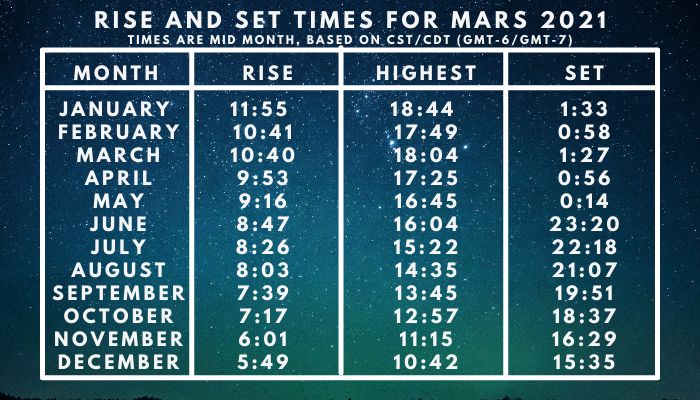
The following chart is set for a mid-US timezone, but the times will be approximately the same in most other northern hemisphere locations.
When is Mars at its Brightest in the Sky?
Because of its diminutive size, Mars isn’t very bright most of the time, and when it does reach maximum brightness, it has nothing whatsoever to do with its size as is the case for Jupiter.
How brightly we view Mars has to do with how close we are to the planet. About where Earth and Mars are in relation to each other, as they make their individual orbits around the sun.
Last year was a banner year for viewing Mars and there won’t be another like it coming up for some time.
At present, Mars is visible, reaching its apex in the sky about midnight. The red planet is currently at its brightest and will stay like that until a good part of November has passed. For now, Mars is the third most brilliant object seen in Earth’s night.
Mars 2021 Brightness Charts
It is important to keep track of the position of your planet’s brightness, as it will change throughout the year.
You can see that at the beginning, your planet shines brightest (the lowest magnitude). As winter gives way to spring, this number falls from 0.1 to 1.8 where it stays until a slight improvement in brightness towards the end of the year.
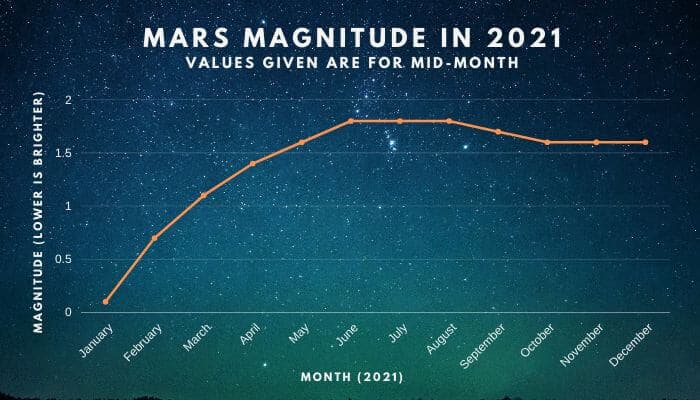
The closer the object is to us, the brighter it appears in our sky. Mars moves farther and farther away from Earth as we go through a year, so its brightness changes during that time period.
You’ll see that Mars is furthest from us as it goes around the Sun in early October before slowly moving back towards us again.
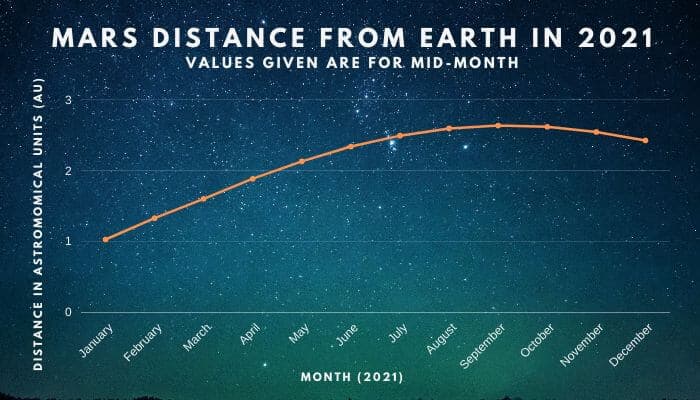
Below we will take a look at how big Mars is in our night sky in 2021.
Mars looks larger in the early part of 2021 as you may expect. It goes smaller as we move throughout the year and is the smallest in early fall.
We take a look at the below chart that tracks the size of Mars during 2021. The diameter is taken from the middle of each month and is measured in arcseconds.
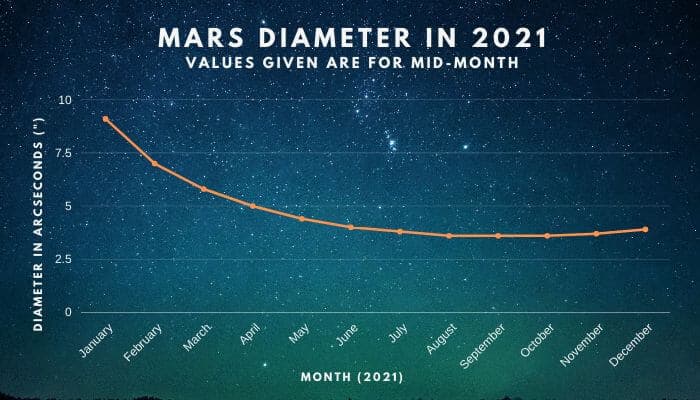
In January, when Mars is at its peak size, it will be more than two-and-a-half times the size that we’ll see late summer/early fall. So if you’re looking for a time to get better views of our red neighbor in space – this should work!
When Can You See Mars Through a Telescope?
One of the five brightest planets, Mars can be seen with the naked eye. However, since it Is one of the smallest planets in our solar system, second only to Mercury, it can be hard to see even with the use of a telescope.
The tremendous distance between Mars and Earth fluctuates astoundingly over a 2 year period. When at their closest, they can be just 35,000,000 miles apart.
Then when they are on opposite sides of their orbits, Mars can be 250,000,000 miles away.
The best time to see Mars through a telescope is when it’s opposite the sun as related to the Earth, which occurs every two years.
Mars can then be seen from sunset to sunrise and achieves its highest point in the sky in the middle of the night. You can usually look for at the tip of the horizon.
This is the time (within a few days) when the planet is closest to the Earth and thus is best seen through a telescope.
Also, don’t be concerned that you need to go off to a vacant lot somewhere in order to view Mars with your telescope. It doesn’t have to be pitch blackout for you to effectively see this planet.
While deep-sky objects can appear very dim due to improper lighting, but the planets are bright and can be seen just from no matter where you are with your telescope. So don’t worry, your backyard will be an ideal spot.
How to Get the Best View
In order to be able to note more factors of the surface of Mars, it makes a difference if you use a telescope filter to improve surface contrast and divulge more features that you may not notice without the filter.
The thing that is so wonderful about filters is that they eliminate unnecessary light from your sight, allowing only useful colors to remain.
With fewer colors attacking your eyes all at once, your brain finds it a lot easier to interpret exactly what it’s seeing so that you can take note of the multiple traits on the surface of the planet.
Furthermore, keep in mind that gazing through a telescope requires some skill, and the only way you get that is through practice. Don’t be impatient.
Your eyes need time to become accustomed to the dark and seeing the world through the eyepiece of the telescope. Also, you might try keeping both of your eyes open. If you find having the eye you aren’t using open is bothersome, the cover it.
The reason for this is that it is more difficult for your eye to relax if you are pressuring one eye to stay shut.
Mars Opposition
With the exception of the several weeks when it’s in conjunction and consumed by the fierce glare of the sun, Mars is practically always able to be seen.
The trouble is that it’s usually much too far away to disclose very many features. This is true even if you use a large backyard telescope to try and view it.
It’s when Earth and Mars are traveling around the sun than Earth has a chance to catch up with Mars by using the inside track and can get rather close. This is the time when Mars shows up opposite the sun in the night sky, and that is what astronomers call Mars is in opposition.
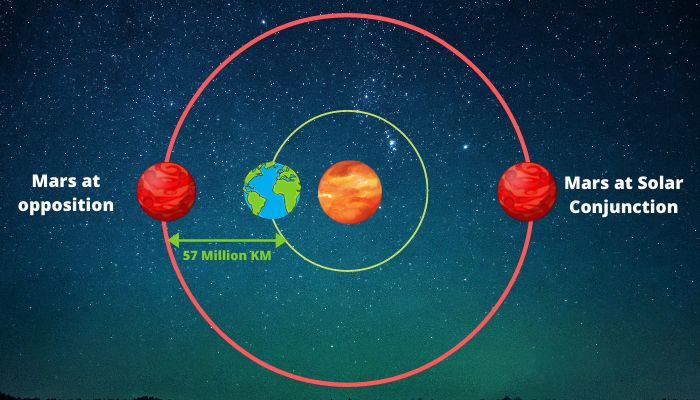
How to Find Mars With Your Phone
You don’t have to be an astronomer to find Mars, the constellations, or any other celestial object in the night sky. Just ask your phone.
In this day and age, there are a lot of stargazing apps for iPhone and Android that can assist you in locating stars, planets, comets, and even satellites.
All you have to do is extend your phone out directly in front of you and move it across the sky – whichever app you happen to be using will update your screen in real-time and you will find exactly what you are seeking.
In the case where you can’t seem to locate what you’re looking for, just enlist the help of the search function and an arrow will show up to point you right in the direction you need to look.
How to Find Mars In a Telescope
While Mars is not exhibiting its best glory this year, the earlier in the year that you try to view Mars through a telescope, the bigger and more visible it will be.
Finding Mars With a Small Telescope
- Assuming that you already know how to use a telescope align the finder scope. Point it at the red planet and use a wide field of view eyepiece to take a look and see what you can actually take note of.
- Don’t worry about mistaking Mars for a star, because real stars will keep the appearance of tiny specks of bright light, but Mars will be seen as one precise disc, although it will continue to get smaller as 2021 proceeds.
- Be sure and magnify things so that you can get an accurate view of their surface. Still take into consideration that this is not the best year for seeing all the details of Mars’ surface.
Which Telescope is Best For Observing Mars?
In truth, all you need to actually get a clear view of Mars through a telescope is a manual telescope.
A small telescope with a 60mm to 80mm aperture should adequately display the most well-known features of the planet, but it will still be difficult to see the intricate details.
But if you want to do a bit more sophisticated viewing, a telescope of 8″ or larger is recommended. You will find that a Dobsonian telescope can be purchased at a reasonable price and will serve this purpose excellently.
If you aim to obtain a larger and more detailed view of Mars, splurging a little and opting for a telescope with a focal length as long and an aperture as large as you can manage to pay for and conveniently transport and use is a great idea.
The reason is that the longer the focal length, the larger the image you will receive, while a larger aperture provides a great resolution of fine detail.
Just keep in mind that there is nothing really wrong with using a 4″ telescope. In truth, you might actually be amazed at just what such a telescope can do.
So don’t feel that you absolutely must have a large telescope to successfully view Mars.
Which Eyepieces And Filters For Observing Mars
If you are wondering which eyepieces are the best for viewing Mars, the fact of the matter is that practically any good eyepiece will be just fine, particularly those that provide a medium and high magnification.
The highest magnification that you can use relies on the quality of the seeing conditions there are and the aperture of your telescope.
With filters, it’s best to use one or two color filters so that you are able to have the ultimate viewing experience. These filters are available in metal cells that will easily thread into the back of an eyepiece.
Eyepieces
Basically, a magnification of 30-50x the aperture (in inches) succeeds fine on nights where the viewing is of average to good quality.
Take this, for instance, if your telescope is 4-inches, try 120x to 200x. Should you have an 8″ telescope, try 240x to 400x. Managing to obtain the best view is really a matter of trial and error. You just have to keep working on it until you are satisfied.
Furthermore, you don’t need an expensive, super-wide-field eyepiece in order to obtain a great view of Mars or other planets. Good Plossl eyepieces come highly recommended, as do their slew of modern variations.
Filters
A lot of the standard color filters will aid you with better being able to spot the features on the surface of Mars and in the atmosphere surrounding the planet. Below are some suggestions for color filters for observing Mars (in order of usefulness):
Red (#23A, #25, #29) – provides the ultimate in contrast of surface traits, improves the ability to view fine surface particulars, and the boundaries of the polar cap and dust clouds.
Blue (#80A, #82A, #38A) and deep blue $47 – displays atmospheric clouds, limb hazes, discrete white clouds, etc., and darkens reddish features.
Light Green (#56) – makes red and blue features appear darker, improves viewing of surface fogs, ice patches, and polar caps.
Orange (#21 or #23A) – makes for greater contrast between light and dark traits and is able to penetrate most clouds and hazes.
Yellow (#12, #15) – makes desert regions show up brighter, and darkens brownish and bluish features.
What Does Mars Look Like Through a Telescope?
Even if you are using an amateur telescope you can rest assured that it will display some traits of Mars’ rugged terrain and surface characteristics.
Large formations will also be able to be seen and will show up as dark expanses. Some areas are clear due to the dust raised by the planet’s winds. If you’re lucky, you might even be able to see the ice scopes at the poles.
Telescope Views of Mars
2-inch telescope – Being the smallest aperture size, this is normally a telescope for individuals just beginning their journey through the heavens. Its size will not allow you to form a clear image of Mars, so you will probably end up seeing a bright, reddish-colored disc.
4-inch telescope – Now your telescope aperture should be able to gather a little more light and provide you with a view of Mars that is truly impressive. If you want to make the image even better, you might decide to use an eyepiece that will increase magnification between 120x to 200x.
8-inch telescope – Under ideal conditions, this telescope can even provide 300x magnification which would vastly improve the ability to see the planet’s surface. Also, it would be a good idea to place an orange filter on the eyepiece so that the darker characteristics of the planet will stand out more vividly against the orange background.
10-inch telescope – The ultimate in observing this small planet. You will be able to see plenty more of Mars’ unique features, such as the north polar cap and dark markings.
Can You See Mars Without a Telescope?
One of the five brightest planets, Mars can be seen with the naked eye. Mars should be visible even without the aid of a telescope from nightfall until the morning light. While look at Mars, the bright star Antares should be visible and also Saturn.
When observing Mars without the aid of a telescope, it is simply not possible to make out any details like you would be able to do with either a refractor or a reflector telescope. Usually, planets look like stars to the naked eye.
However, during opposition Mars will be a great deal more visible appearing to be a star with a reddish tinge around it, and serving up wonderful visual pictures as it nears the Moon.
You can also try using binoculars, but this really won’t make much of a difference. They just don’t have the strength to focus powerfully enough.
Some people claim that they prefer to look at Mars without a telescope because it is somewhat small and anti-climatic when seeing it through the lens of a telescope.
The truth of the matter, however, is that it all depends on the type of telescope you use. If you have the proper equipment, you should have no trouble viewing Mars with a telescope, and it should prove to be quite an enjoyable experience. It doesn’t matter what size telescope you use, just using one makes a huge difference and opens up a whole world of color and brightness that you just cannot experience otherwise.
Conclusion
We hope that this guide to viewing Mars through a telescope has helped you to gain some new information about this fascinating little planet and to learn a bit more on how to best observe it.
Investing in a telescope is always a worthwhile way to spend your money, and astronomy can be a very enjoyable hobby.
In the end, it doesn’t matter if you have a large telescope or a small one, or even just a simple pair of binoculars. Mars is an interesting planet and you should try to see as much as possible of it when the opportunity presents itself.
If you enjoy Planetary Observation then you will love that we have on offer Venus, Saturn, Jupiter, Mercury, Uranus, Neptune guide to help you get the best views. If you enjoy plant facts we also have this topic covered including Mars facts that I hope you enjoy.



